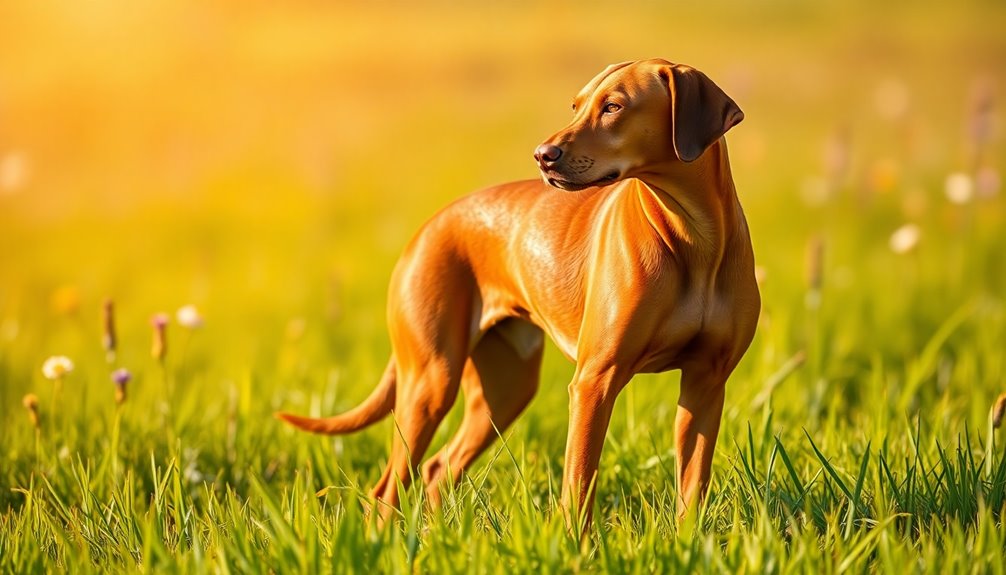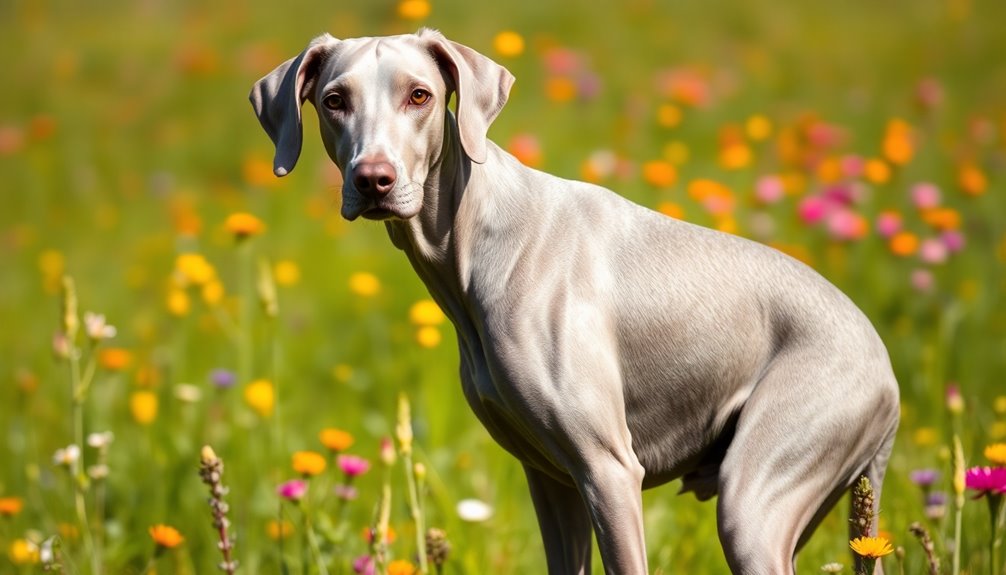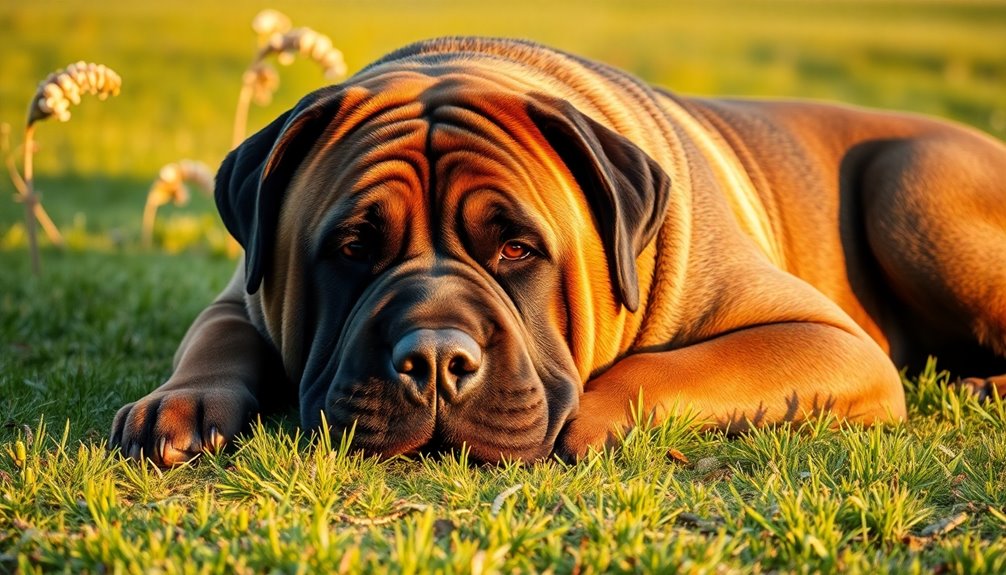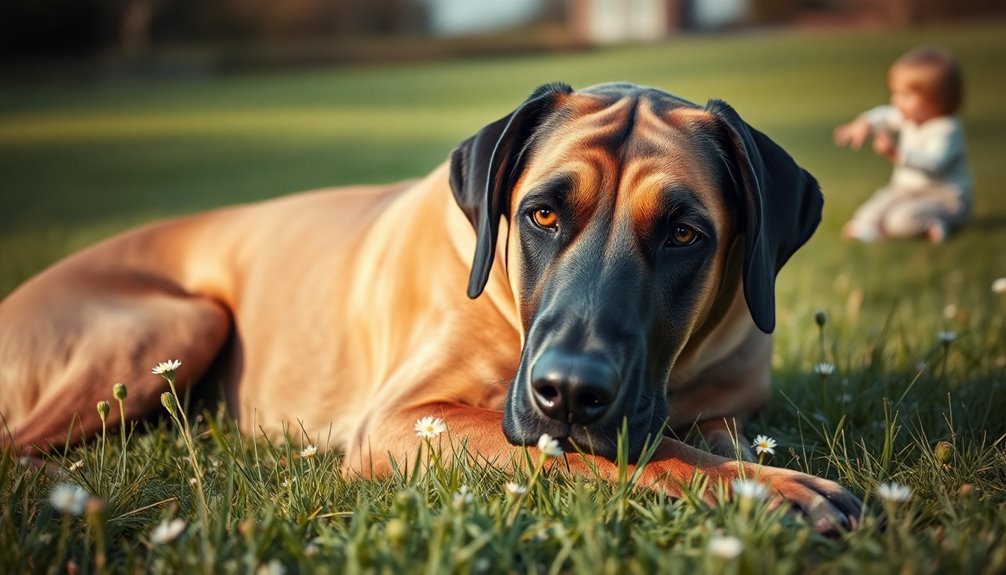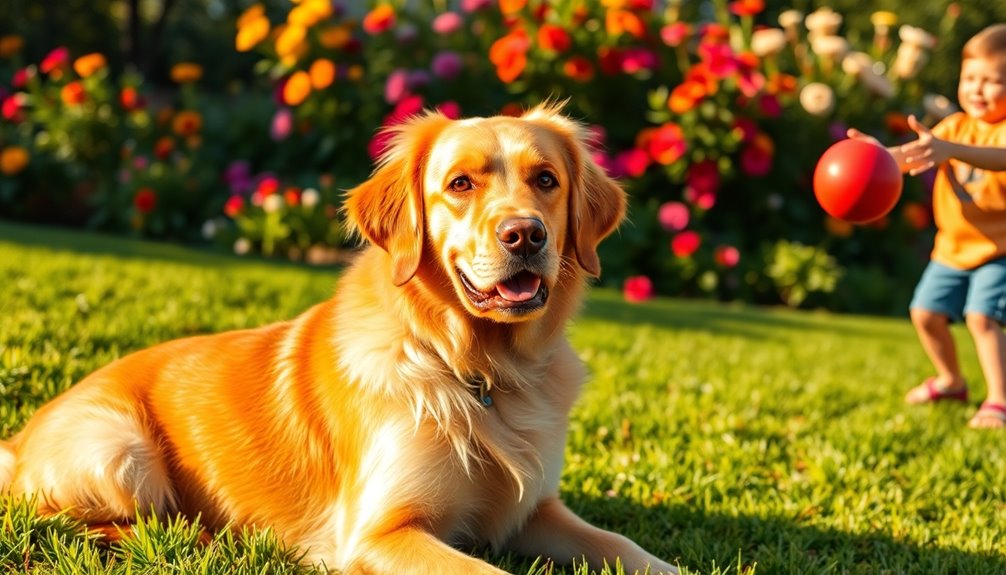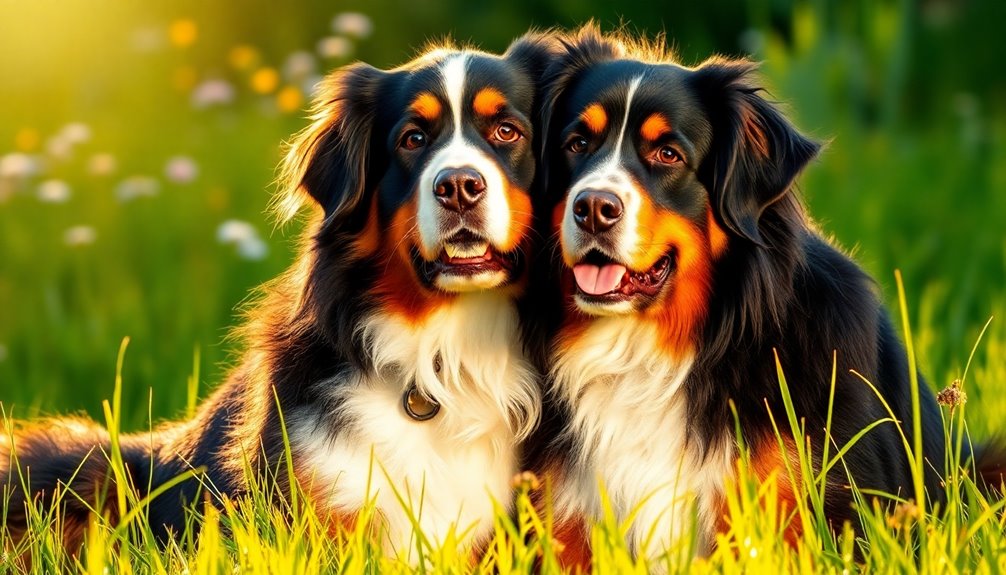The Vizsla's sleek, athletic build and vibrant golden rust coat make it a standout as a hunting companion. Known for their high energy and intelligence, they thrive on exercise, requiring at least two hours daily. These loyal dogs form strong bonds with their families and enjoy being involved in every aspect of your life. Their playful, affectionate nature earns them the nickname "velcro dogs." However, they need early socialization and gentle training to flourish. If you're considering adding a Vizsla to your home, there's plenty more to explore about their care and compatibility.
Key Takeaways
- Vizslas are medium-sized dogs with a sleek, short coat in golden rust or coppery red, requiring minimal grooming.
- Originating in Hungary, Vizslas were bred as loyal hunting companions, highlighting their energetic and driven nature.
- They thrive in active households, needing at least two hours of daily exercise for optimal health and happiness.
- Known for their intelligence and affectionate demeanor, Vizslas form strong bonds with families, making them excellent companions.
- Early socialization and positive reinforcement training are essential to channel their energy and prevent behavioral issues.
Introduction
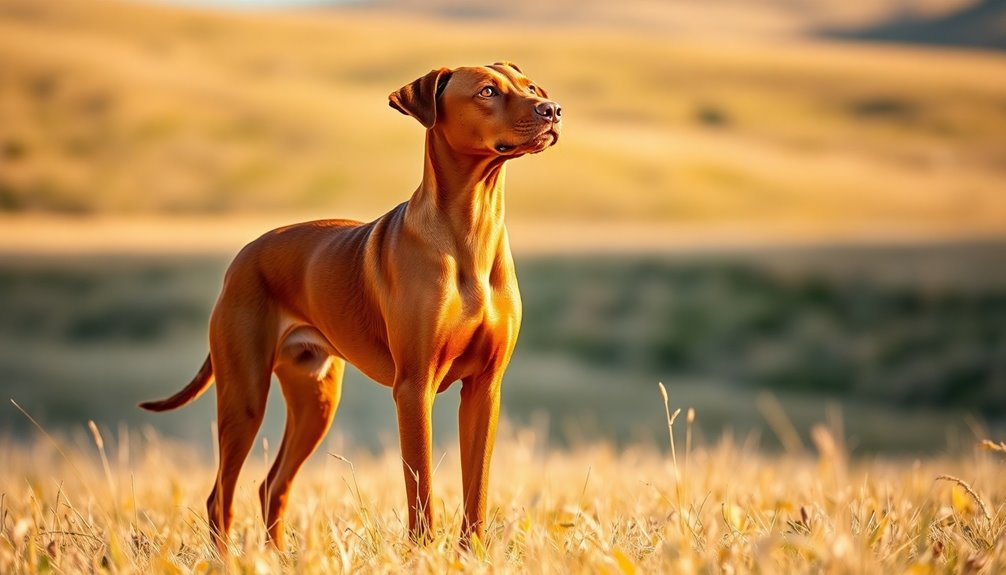
The Vizsla is a remarkable hunting companion known for its loyalty and intelligence. With a medium-bodied, compact frame, these dogs typically weigh between 45-65 pounds and stand about 21-24 inches tall. Their short, sleek coat shines in shades of golden rust or coppery red, complemented by dark brown eyes and drooping ears that give them an affectionate appearance.
These dogs are gentle and loving, forming strong bonds with their families. However, they're also very active and need daily exercise to stay healthy and happy. Their high intelligence makes them eager-to-please learners, but they can experience separation anxiety and may be sensitive to loud noises. Vizslas are known as "Velcro dogs(Temperament)" due to their strong attachment to family members.
When it comes to hunting skills, Vizslas possess a highly developed sense of smell and excellent tracking abilities. They've a natural pointing instinct and can retrieve prey with a soft mouth, showing their gentle handling capabilities.
With high stamina and endurance, they're well-suited for long distances across various terrains. Overall, a Vizsla is an ideal partner for anyone seeking an enthusiastic and dedicated hunting companion.
History and Origin
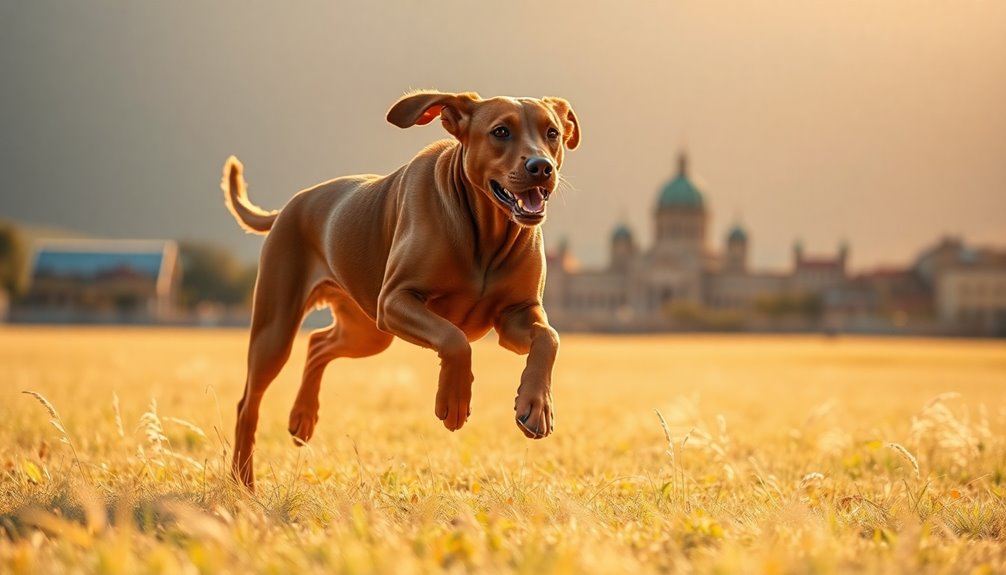
The Vizsla has roots tracing back to eighth-century Hungary, where it emerged as a favored hunting companion of the Magyar tribes. Known for its exceptional skills in bird hunting and retrieval, this breed became an integral part of life in the Carpathian basin. Its history is rich with the legacy of noble hunters and the preservation efforts that followed, shaping the Vizsla into the beloved breed you see today. Despite facing multiple extinction events throughout history, dedicated breeders worked tirelessly to maintain the breed's integrity.
Where and when the breed originated
Originating in the heart of Hungary, Vizslas trace their lineage back to the 8th or 9th century, with some sources even suggesting roots as far back as the 11th century. The ancestors of Vizslas were hunting dogs belonging to the Magyar, a nomadic tribe that settled in the Carpathian Basin, specifically in what's now Hungary.
Primitive stone etchings more than 1,000 years old depict Magyar hunters with their falcons and Vizslas, highlighting the breed's long-standing association with hunting.
Throughout history, Vizslas endured significant challenges, including the Turkish occupation from 1526 to 1696 and the Hungarian Civil War of 1848-49. By the late 19th century, the breed faced near extinction, with only about a dozen true-type Vizslas remaining. The survival of the breed during these turbulent times can be attributed to dedicated breeders and enthusiasts.
Recovery efforts, led by passionate individuals like Mrs. Elizabeth Mihalyi, aimed to restore the breed. The aristocracy played a crucial role in preserving Vizslas' pure bloodlines, as they valued the dogs for their hunting abilities.
This rich history reflects the breed's cultural significance and enduring legacy as a beloved hunting companion.
Bird Hunting and Retrieval
Bird hunting with Vizslas has deep historical roots, and their natural instincts make them exceptional hunting partners. Bred for centuries to match the speed and strength of cavalry, these dogs possess a strong bird drive, making them adept at locating and pointing game like pheasants, grouse, and woodcock.
You'll appreciate their ability to range widely, often covering up to 100 meters on either side of you while using their keen sense of smell. To ensure effective retrieval, training begins with artificial aids like bumpers and scented dummies. Using a training table helps teach your Vizsla to return directly to you. Incorporating gentle training methods is crucial, as Vizslas are sensitive and respond best to positive reinforcement. Additionally, force fetching techniques can significantly improve your dog's consistency in retrieving live birds during hunts.
During fieldwork, teaching your dog steadiness is essential to prevent them from flushing game prematurely. Wind direction plays a significant role, and consistent practice across various terrains will enhance their hunting skills.
Vizslas can retrieve on land and in water, adapting well to different conditions. With the right training and motivation, you'll find your Vizsla excels in retrieving, whether on dry ground or splashing through a lake.
Physical Characteristics
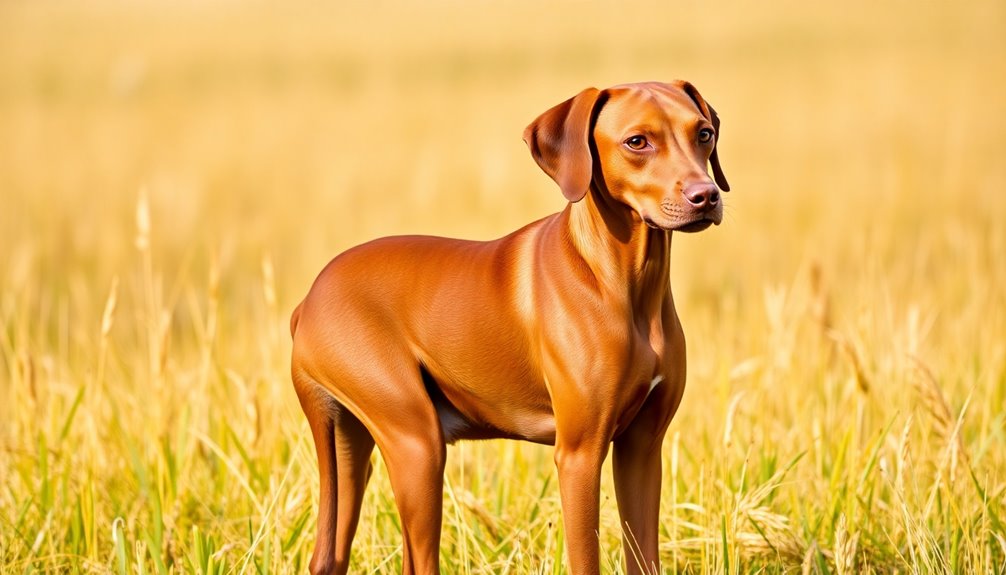
When you think about a Vizsla, picture a medium-sized dog weighing between 45 to 65 pounds with a sleek, compact frame.
Their short, velvety-smooth coat shines in a solid golden rust color, offering a stunning appearance that's easy to maintain. This color variation embodies the breed's fiery yet friendly nature, enhancing their charm as both hunting companions and family pets.
With their graceful build and keen athleticism, these dogs are truly a sight to behold.
Size, weight, and coat details
Vizslas are medium to large-sized dogs, known for their athletic build and graceful appearance. Males typically stand between 22 to 27 inches tall and weigh between 45 to 66 pounds, while females range from 21 to 24 inches in height and 40 to 55 pounds in weight. European Vizslas tend to be taller and heavier than their North American counterparts, with some females weighing as little as 35 pounds and males exceeding 80 pounds. By the time they reach 15 months, their growth is complete.
Their coat colors include shades like French-row yellow, orange, copper-brown, and russet gold, with permissible small white markings on the fore-chest or neck. You might notice saddle-type marks along the back, which are quite common. While the smooth coat is the standard, some Vizslas can have wire or longhaired varieties, though the latter isn't typically encouraged by breeders. The smooth coat lies close to the body without an undercoat, making grooming minimal.
Interestingly, Vizslas are also known for their high energy levels, which require regular exercise and mental stimulation to keep them happy and well-behaved. Whether you choose a male or female, you'll enjoy a sleek companion with a striking look and a lively personality.
Short, Sleek Coat Texture
The Vizsla's short, sleek coat is one of its most striking features, measuring approximately 1 inch in length. This close-lying coat not only enhances the breed's elegant outline but also serves a functional purpose.
As a double-coated breed, the Wirehaired Vizsla has a dense undercoat that's water-repellent, protecting it against harsh weather and injuries. The wiry outer coat safeguards your dog during cold water retrieves and while navigating through thorny brush.
You'll notice pronounced eyebrows and a strong, harsh beard on the Vizsla, adding to its distinctive look. However, the coat on the lower legs and belly is shorter and softer, balancing the overall appearance.
To maintain that correct wire texture, you'll need to strip the dead coat by hand, ensuring you avoid over-grooming, which can damage the coat's integrity. Proper coat texture is crucial, as it must not obscure the dog's body outline.
The uniform golden rust color, with permissible white markings on the forechest and toes, ties everything together.
Temperament and Personality
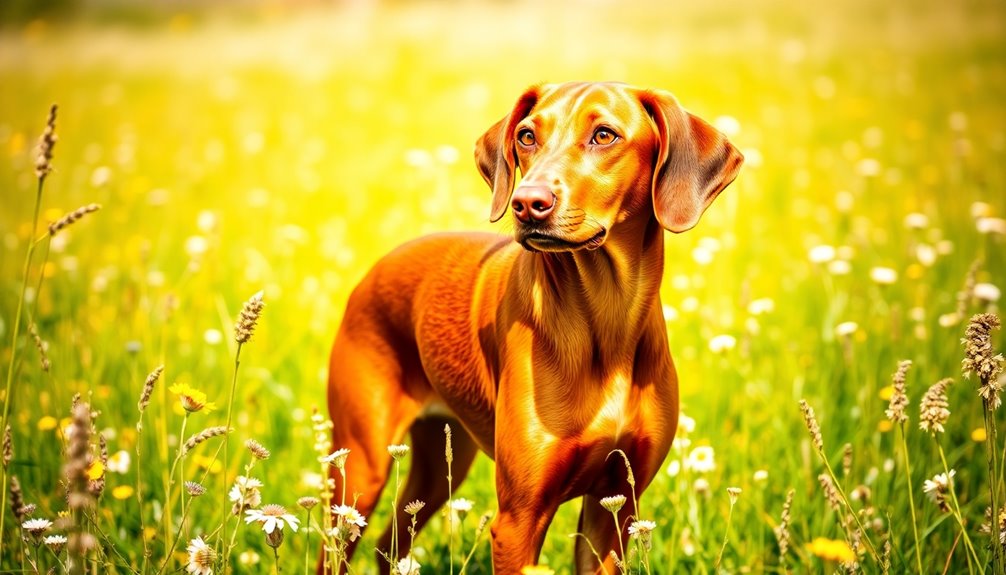
When you think about a Vizsla's temperament, you'll find they're playful and eager to please, making them fantastic companions for families and individuals alike. Their friendly nature allows them to get along well with other pets, but early socialization is key to ensuring harmony. With their energetic spirit, they thrive in active households where they can enjoy plenty of exercise and love. Their affectionate demeanor makes them known as velcro dogs, as they often follow their owners everywhere, desiring constant companionship.
Playful and Eager to Please
With their playful antics and boundless energy, Vizslas make for an engaging and lively companion. These dogs thrive on physical activity, so you'll need to keep them busy with long hikes, games of fetch, or even swimming sessions. If they don't get enough exercise, their energy can turn into restlessness, leading to potential destructiveness.
Thankfully, even as adults, Vizslas maintain a delightful, puppy-like demeanor.
Their eagerness to please is one of their most endearing traits. Highly intelligent, Vizslas excel in obedience training and respond well to positive reinforcement. Use treats, praise, or playtime to keep them motivated, and be consistent in your commands to ensure effective training. Their high intelligence allows them to quickly learn new commands, making training sessions an enjoyable experience for both you and your dog.
Remember, they're sensitive souls; a firm but gentle approach works best.
Supervision is important, especially when they're around young children, given their high energy levels. With the right guidance and care, you'll find that Vizslas not only learn quickly but also form deep, loyal bonds with you and your family.
Their playful nature and eagerness to please make them a joy to have around, turning every day into an adventure.
Suitability for families, individuals, or other pets
Vizslas are incredibly adaptable dogs, making them suitable companions for families, individuals, and even other pets under the right conditions. Their loyalty and affection shine through, often earning them the nickname 'Velcro dogs' because they love being close to you.
However, they need lots of exercise and attention, so if you lead an active lifestyle, they're a perfect match. Keep in mind that they might be too large for households with very young children, as they could accidentally knock them over. With their need for at least 2 hours of exercise daily, they thrive on physical activity and mental stimulation.
For individuals, being active is key. If you're often away or can't commit to providing ample exercise, a Vizsla might develop separation anxiety or destructive behaviors. They thrive on companionship and need proper training to manage their smart, sometimes stubborn nature.
When it comes to other pets, Vizslas are generally sociable but have a strong prey drive. This makes careful introductions to smaller animals essential. Early socialization is crucial for ensuring they get along well with other dogs and pets.
Health and Lifespan
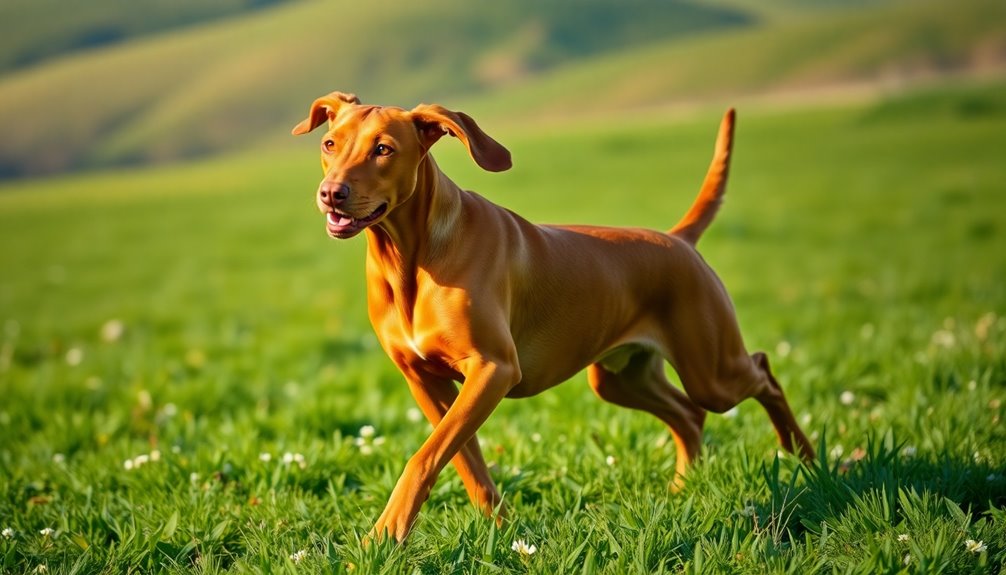
When you bring a Vizsla into your life, it's important to know their average lifespan ranges from 12 to 14 years, with some living up to 15. They can be prone to certain health issues like allergies and hip dysplasia, so staying on top of their wellness is crucial. Regular veterinary care is essential for early detection of any health issues and can significantly contribute to their longevity.
Typical lifespan of the breed
The typical lifespan of a Vizsla ranges from 10 to 15 years, with many living comfortably between 12 and 14 years. This breed can even reach up to 15 years, which is longer than many similar breeds. Being a medium-sized dog, Vizslas often enjoy a longer life than their larger counterparts.
However, factors like nutrition, health care, and genetics play a significant role in their longevity. To ensure your Vizsla thrives, adequate physical activity is crucial. They need over 40 minutes of daily exercise, including walks, runs, and hikes.
Regular grooming not only keeps their coat healthy but also helps prevent potential health issues. A spacious living environment allows them to move freely and stay active.
Strong social bonds and mental stimulation are vital for their well-being, so keep them engaged with challenging activities. It's important to note that the breed's history as tracking game hunters contributes to their high energy levels and need for consistent exercise.
Remember, Vizslas don't do well in kennels; they thrive being close to their owners. With proper care, regular vet check-ups, and a healthy lifestyle, your Vizsla can enjoy a long and fulfilling life by your side.
Common health concerns or genetic predispositions
Many dog owners might be surprised to learn that Vizslas are prone to several health concerns, some of which have genetic roots. One of the most notable is Cerebellar Cortical Degeneration (CDD), which causes incoordination and impaired balance.
You should also be aware of Exercise-Induced Collapse (EIC), a neuromuscular disorder that leads to weakness after intense activity. Blood disorders like Von Willebrand's Disease and hypofibrinogenemia can cause severe bleeding, while canine epilepsy may lead to unpredictable seizures.
Vizslas are also susceptible to bone and joint disorders, such as hip and elbow dysplasia, which can result in arthritis and chronic pain. As your dog ages, you might notice stiffness or lameness. Additionally, their risk of obesity can lead to joint problems, metabolic disorders, and heart disease.
Eye issues, including glaucoma and canine cataracts, can impair vision and may require surgical intervention. Moreover, dental disease can lead to more severe health complications, while obesity exacerbates joint problems.
Regular check-ups are essential to catch these concerns early. Being vigilant about these common health issues can help you provide the best care for your energetic Vizsla.
Tips for maintaining health and wellness
To ensure your Vizsla remains healthy and vibrant, focus on a balanced regimen that includes ample exercise, mental stimulation, and regular veterinary care. Aim for 60 to 90 minutes of vigorous exercise daily, incorporating activities like running, swimming, and playing fetch. Your Vizsla's high energy levels demand extensive physical engagement, so provide plenty of space for retrieving and long play sessions.
Mental stimulation is equally important. Use puzzle toys and scent games to keep boredom at bay, and engage in obedience training to enhance their mental agility. Regular check-ups are crucial for early detection of health issues, ensuring that any potential concerns are addressed promptly. Interactive play sessions not only challenge their minds but also strengthen your bond.
Don't overlook regular veterinary care. Schedule routine visits for early detection of health issues, adhere to vaccination schedules, and discuss preventative treatments for fleas, ticks, and worms. Regular dental cleanings will help prevent gum disease.
Grooming and hygiene matter too. Brush your Vizsla regularly to remove loose hairs and dander, bathe them every 4 to 6 weeks, and keep an eye on their skin for irritation. Clean their ears to prevent infections and trim toenails to maintain foot health. Following these tips will keep your Vizsla thriving!
Care Requirements
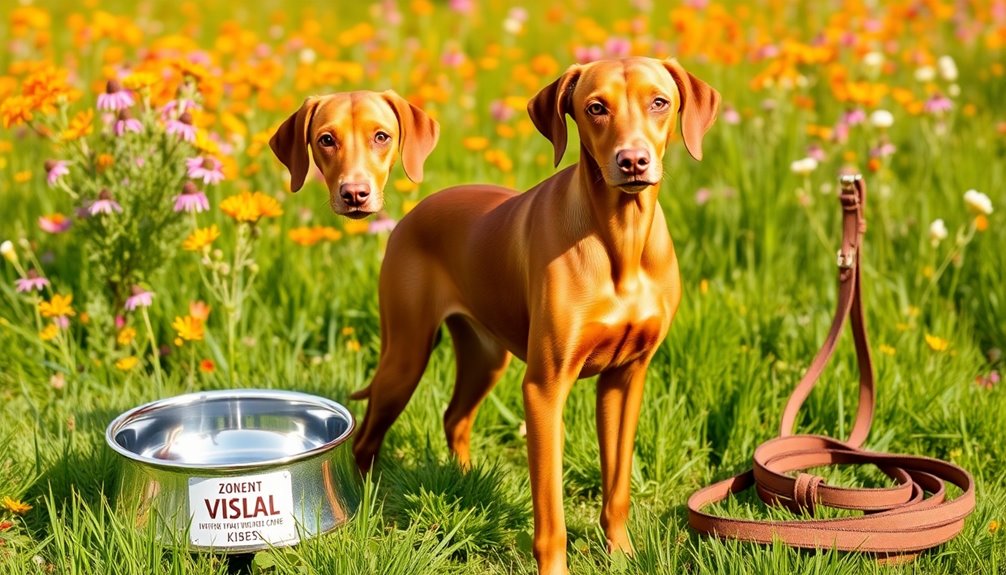
Caring for your Vizsla involves meeting their exercise needs, grooming requirements, and nutritional demands.
You'll find that they shed minimally, making grooming a breeze, but they do need plenty of physical activity to keep their energy levels in check. Regular exercise is crucial to prevent obesity and related health problems, as Vizslas have high exercise needs. Engaging in regular physical activity can also support emotional regulation, enhancing their overall well-being.
It's essential to feed them a high-quality diet while following specific feeding tips to ensure their overall health.
Minimal Shedding, Easy Grooming
Vizslas are known for their minimal shedding and straightforward grooming needs, making them a great choice for those who prefer a low-maintenance canine companion. While they're moderate shedders, you'll find that they shed consistently throughout the year, with heavier shedding during spring and fall. Factors like age, diet, and overall health can influence shedding, so maintaining a balanced diet and regular vet check-ups can help keep it in check.
For grooming, aim to brush your Vizsla at least once a week using a rubber grooming mitt or a soft bristle brush. This helps remove loose hair and distribute natural skin oils. You won't need to bathe them often—every 3-4 months or as necessary should suffice. Additionally, providing ample exercise is crucial for their overall well-being, as Vizslas are energetic dogs that thrive on physical activity.
When you do bathe them, use a mild dog-specific shampoo for the best results. To manage shedding at home, regular cleaning is key. Vacuuming, sweeping, and using a lint roller can effectively keep your space hair-free. Don't forget to wash your Vizsla's bedding regularly to minimize fur buildup. With minimal grooming requirements and proper care, you'll enjoy a clean and happy companion.
Exercise requirements and energy levels
Maintaining a clean and well-groomed Vizsla is just one part of ensuring their overall well-being; meeting their exercise needs is equally important. These energetic dogs require a minimum of one hour of exercise daily, but ideally, you should aim for two hours. To keep them happy and healthy, incorporate brisk walks, runs, and off-leash playtime into their routine. You might consider two 30-45 minute sessions each morning and evening.
Variety is key when it comes to exercise. Mix in activities like hiking, biking, and swimming to keep things interesting. Adult Vizslas can handle agility training can also provide both physical and mental engagement.
Make sure to include socialization opportunities, like visits to dog parks or playdates with friends, to fulfill their social needs.
Adjust the exercise intensity based on your Vizsla's age. Puppies need shorter sessions, while seniors may require modified routines. Always consult with your vet to tailor an exercise plan that suits your dog's health.
Feeding tips and diet recommendations
Feeding your Vizsla a balanced diet is crucial for their overall health and vitality. Focus on high-quality proteins like chicken, beef, or fish to support muscle maintenance. Healthy fats, especially omega-3 and omega-6 fatty acids, provide energy and promote a shiny coat. Including essential vitamins and minerals in their diet can further enhance their immune system and overall well-being.
For carbohydrates, choose complex sources such as vegetables, herbs, and berries to aid digestion and boost energy levels.
Adult Vizslas generally need 2 to 3 cups of dry dog food daily, split into two meals. Adjust portions based on your dog's size, age, and activity level. It's important to consult your vet for tailored feeding recommendations and to avoid both overfeeding and underfeeding.
If you have a puppy, opt for a calorie-rich diet to support growth, while senior Vizslas might benefit from a lower-calorie plan. Be cautious of food allergies and consider limited ingredient diets or raw food options if needed.
Always provide fresh water, especially after exercise, and consider incorporating wet food for hydration.
Lastly, avoid strenuous activity right after meals to reduce the risk of bloat, and use slow-feeder bowls to promote healthy eating habits.
Training and Socialization
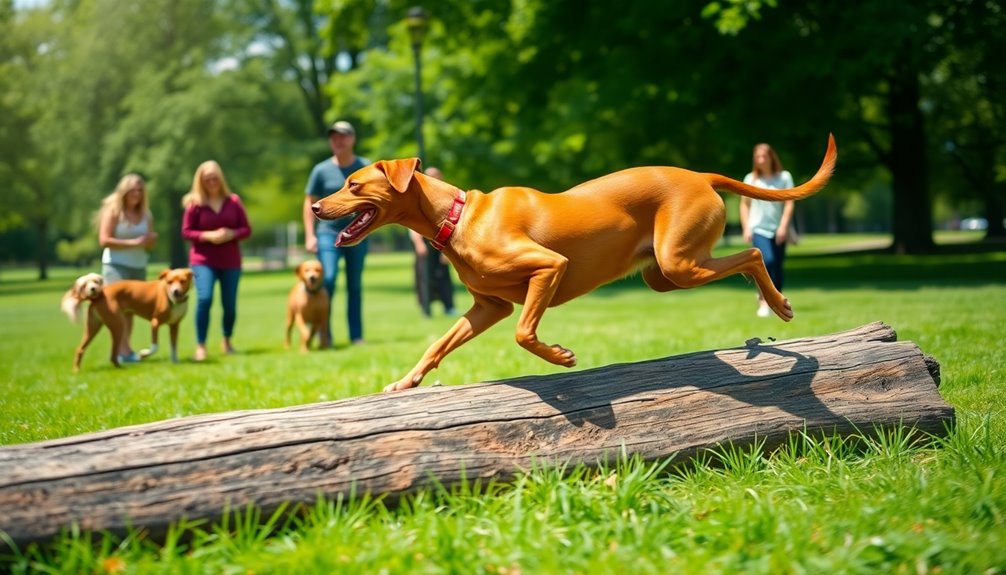
Training your Vizsla can be a rewarding experience, as they're highly responsive to commands when you use positive reinforcement. It's important to remember that early training is crucial to mitigate any potential behavioral issues in adulthood, setting a strong foundation for their development. Regular outings to pet-friendly cafes or parks can also enhance their socialization skills and adaptability.
Start with gradual introductions to new environments to help them adjust without feeling overwhelmed, especially during training sessions. Keep an eye out for signs of separation anxiety, as these dogs thrive on companionship and support.
Highly Responsive to Commands
Because Vizslas are inherently eager to please, they respond exceptionally well to commands, making them a joy to train. Their strong desire to learn, rooted in their history as hunting companions, means you'll find them highly trainable. Off-leash training can enhance their learning experience by allowing for greater exploration and exercise, which is vital for high energy dogs like Vizslas.
Start your training with basic obedience commands like sit, stay, and lie down. Use positive reinforcement techniques—treats, praise, and playtime—to encourage desired behaviors. Remember, harsh commands or physical corrections can be counterproductive, given their sensitive temperament.
For effective recall training, call your Vizsla back during walks every few minutes, gradually increasing the distance. Timing is key; avoid calling them when they're distracted. Always give a command just once to prevent delayed responses.
Additionally, never end playtime with a recall to avoid negative associations. Instead, go to your Vizsla to conclude the game.
Involve all family members in training to foster a well-adjusted dog. Socialization should also be part of the process, exposing your Vizsla to various people and well-mannered dogs.
This combination of consistent training and socialization helps your Vizsla master commands and build confidence, ensuring a responsive and obedient companion.
Gradual Introductions to New Environments
Introducing your Vizsla to new environments should be a gradual process that prioritizes their comfort and confidence. Start by exposing them to less stimulating settings, like quiet parks or friendly gatherings, before heading to busier places. This gradual exposure helps prevent overwhelming your puppy.
Use positive reinforcement techniques, such as treats and praise, to create a positive association with these new experiences. Incorporating short, pleasant car rides can also help them associate travel with good outcomes. Visit various locations like pet-friendly stores, outdoor cafes, and different terrains to broaden their experiences. Early socialization is crucial as it shapes long-term social skills and establishes a foundation for confident behavior.
Arrange supervised playdates with other puppies or well-behaved adult dogs to promote healthy social interactions. Ensure these sessions are controlled and positive, teaching your Vizsla appropriate social behaviors.
It's also important to expose them to people of various ages, sizes, and ethnicities in controlled environments, along with introducing them to other pets, like cats or birds.
Maintain a consistent socialization schedule, involving all family members, to help your puppy feel secure. Regular, short sessions can prevent overwhelm, adapting as your dog grows and encounters new situations.
Always observe their body language, adjusting the pace as needed.
Separation Anxiety During Training
Separation anxiety can be a significant challenge during your Vizsla's training and socialization process. As a breed that thrives on human companionship, Vizslas often struggle when left alone, making it essential to address this anxiety early. Symptoms like howling, destruction, and restlessness indicate your dog's discomfort when you're away.
To prevent separation anxiety, start during the puppy stage by gradually introducing alone time and using crate training. This helps your Vizsla learn that being alone isn't a negative experience. Daily exercise and mental stimulation are crucial; activities like running, hiking, and canine sports can help meet their high energy needs, as Vizslas require significant exercise to keep them mentally and physically healthy.
Establishing a routine is also beneficial. Stick to consistent meal, exercise, and departure/return times to create a sense of security. Create a safe space where your dog can relax and decompress. Use positive reinforcement to reward calm behavior during training sessions.
If your Vizsla's anxiety worsens, don't hesitate to seek professional help. A vet or veterinary behaviorist can provide guidance, and in some cases, medication may be necessary. Engaging in obedience training and socialization can further reinforce positive behaviors and ease anxiety over time.
Ideal Living Environment
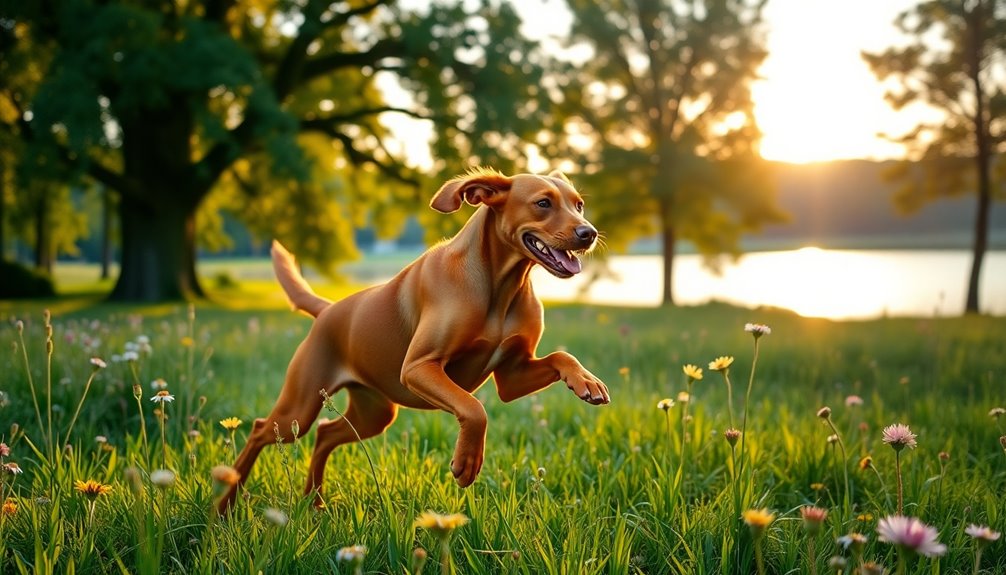
If you're considering a Vizsla, you'll want a home with plenty of outdoor space for them to run and play. These dogs thrive in warmer climates and can be sensitive to heat and humidity, so keeping them comfortable is key. Make sure your living environment can accommodate their active lifestyle and need for companionship. Additionally, be aware that their limited insulation makes them sensitive to cold weather, requiring extra care during colder months.
House With Ample Outdoor Space
Having a house with ample outdoor space is crucial for a Vizsla's well-being. These energetic dogs require a spacious environment to thrive, making homes with large gardens or easy access to expansive green areas ideal. Apartment living isn't recommended unless you can guarantee plenty of outdoor time.
Vizslas need secure environments for off-lead running and exploration, so a large yard is preferred for their exercise activities. You should plan for at least one hour of exercise daily, totaling a minimum of seven hours each week. Activities like walking, jogging, running, or swimming are great ways to keep them fit. Long walks, runs, agility training, and games of fetch will help tire them out. Additionally, their strong physique allows them to excel in various physical activities.
Additionally, Vizslas thrive on both physical and mental stimulation, which helps prevent boredom and destructive behavior. Incorporating interactive puzzle toys, training sessions, and scent work can keep their minds engaged.
Since they form strong bonds with family members, it's essential to ensure they've plenty of social interaction. This way, you'll have a happy, well-adjusted Vizsla that fits seamlessly into your home.
Heat Tolerance and Humidity Sensitivity
Understanding a Vizsla's heat tolerance and humidity sensitivity is essential for creating an ideal living environment. These dogs are well adapted to warmer climates thanks to their short coat, which helps them tolerate heat better than many breeds. However, it's vital to take standard precautions to prevent overheating. Always ensure they've access to shade and plenty of fresh water during hot weather to keep them cool, especially during their heat cycles. Avoid excessive exercise during the hottest parts of the day to keep them cool.
While Vizslas can manage in humid climates, you need to be extra cautious. High humidity, especially when combined with high temperatures, can lead to overheating. To help manage this, provide a cool, ventilated environment and keep a close eye on their hydration levels. Regularly monitor your Vizsla for any signs of discomfort or overheating, such as excessive panting or lethargy.
Energetic Athletes, Great Swimmers
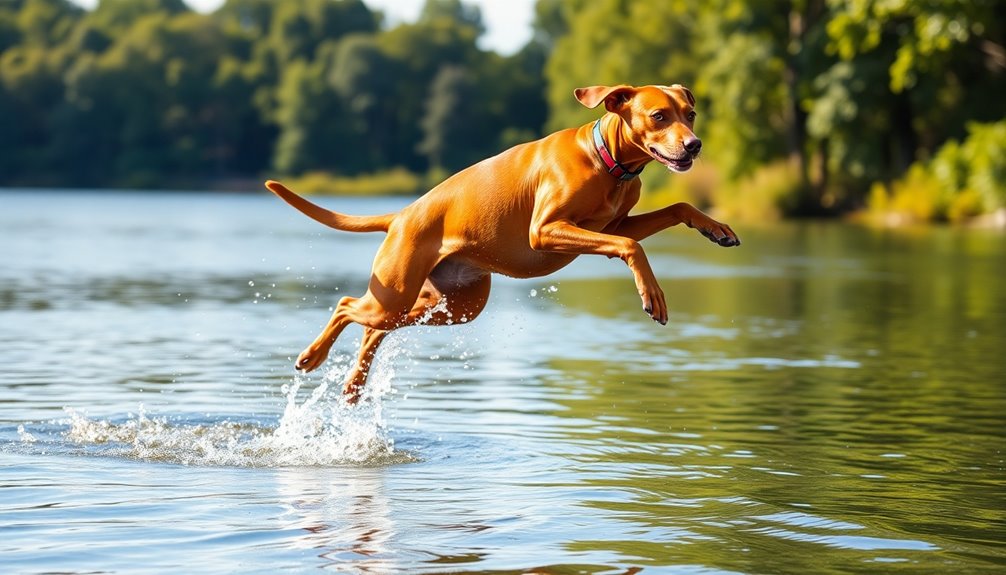
Vizslas have a natural affinity for water, making them exceptional swimmers and enthusiastic participants in water activities. If you've seen the movie "The Incredible Journey," you might recall how a Vizsla's spirit shines through in both play and companionship. With their webbed paws and athletic build, these dogs are ready to make a splash while enjoying every moment spent in the water. Their high energy levels ensure they can swim for extended periods, showcasing their endurance and love for vigorous activities.
Natural Affinity for Water
With their natural affinity for water, Vizslas excel as energetic athletes and remarkable swimmers. Their webbed paws, a feature common in water breeds, enhance their swimming efficiency and provide excellent balance. This muscular yet sleek build not only makes them agile in the water but also allows them to navigate uneven terrain during hunts.
Their short, smooth coat, devoid of an undercoat, is perfect for swimming, drying quickly and reducing drag. Originally bred in Hungary for hunting, Vizslas are accustomed to working near and in water. Their history as retrievers means they possess an innate drive for water-based tasks, further honing their swimming abilities. Additionally, most Vizslas enjoy water, making them enthusiastic companions during beach outings.
Most Vizslas take to the water naturally, especially if introduced early and positively reinforced. Using life jackets and starting in shallow areas can help build their confidence.
However, safety is paramount. Avoid letting your Vizsla swim in very cold water to prevent hypothermia, and be cautious of natural hazards. Always supervise them around water to ensure a safe and enjoyable experience.
With the right approach, your Vizsla will thrive as a water-loving companion.
Vizsla in 'The Incredible Journey
In "The Incredible Journey," the energetic prowess of the Vizsla shines through as a testament to their athleticism and affinity for water. These dogs are built for endurance, needing around 1.5 hours of exercise daily, whether it's running, hiking, or swimming.
Their speed and agility make them ideal running companions, allowing you to enjoy fast-paced activities together. Just remember to keep them on a leash during runs, as their excitement can lead them to dash off.
Vizslas also excel in water. With webbed feet that enhance their swimming capabilities, they can navigate rivers, lakes, or even the ocean. Swimming serves as an excellent low-impact workout that builds muscle strength and promotes respiratory health, making it suitable for Vizslas of all ages. Engaging in activities like agility training or lure coursing not only caters to their athletic nature but also provides essential mental stimulation, as the flirt pole game is a great way to mimic their natural hunting instincts.
As a devoted companion, your Vizsla thrives on being close to you, requiring regular physical activities that also satisfy their emotional needs. Whether you're running or swimming, your Vizsla's energy and enthusiasm will undoubtedly keep you both active and connected.
Active Lifestyle Compatibility
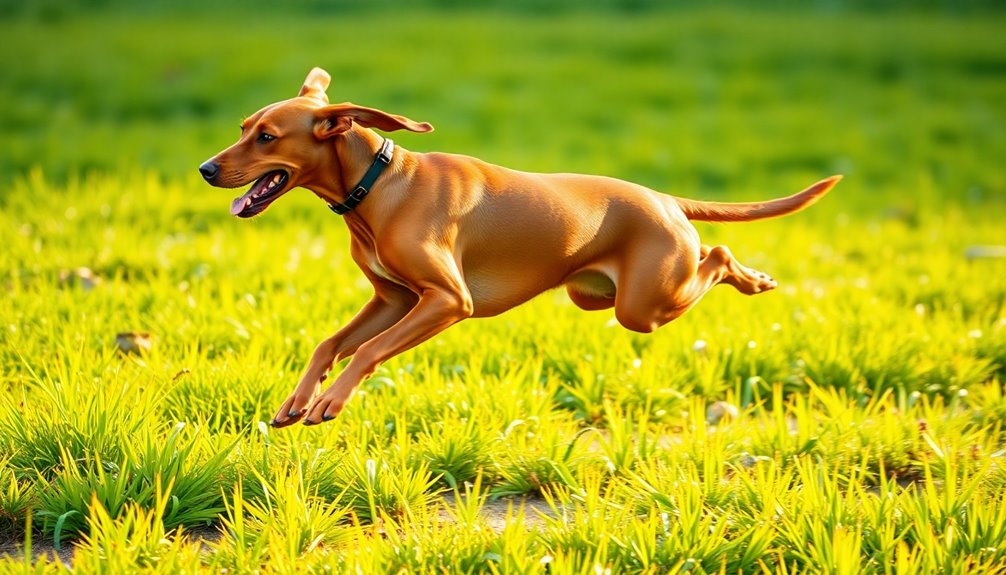
If you lead an active lifestyle, a Vizsla could be the perfect companion for you.
They thrive on daily exercise and need you to commit to at least 1-2 hours of physical activity every day.
Whether it's running, hiking, or playing fetch, your Vizsla will keep you moving and engaged. Their high energy levels mean they excel in environments where they can participate in various activities with their families.
Ideal for Active Individuals
Vizslas are perfect companions for those who lead an active lifestyle, requiring at least 1-2 hours of physical activity daily. They thrive on activities like running, hiking, swimming, and kayaking, making them ideal for outdoor enthusiasts. With their high energy levels, these dogs are endurance animals, maintaining their zest for life even as they age. Additionally, high-energy breeds like Vizslas need structured exercise to stay well-adjusted and avoid destructive behavior.
Don't forget that Vizslas also need mental stimulation to keep boredom at bay. Engaging them with puzzle toys, training sessions, and interactive games is essential. Such mental exercises help manage their energy levels and challenge their intelligence, aligning perfectly with your active routine.
Moreover, Vizslas are social animals that love being part of the family. They bond closely with their owners, thriving on companionship and interactive playtime. While they may be reserved around strangers, early socialization helps them feel more comfortable.
Living in an apartment can work as long as you provide enough outdoor activities. Just remember, they require secure areas for play due to their strong hunting instincts.
Commitment to Daily Exercise
For those committed to providing a high-energy companion, the daily exercise requirements of a Vizsla can't be overlooked. You'll need to dedicate 1.5 to 2 hours of exercise each day, ensuring it's spread across various activities. At least one hour should be vigorous exercise, incorporating running, hiking, or extended fetch sessions. Off-leash time is essential for your Vizsla to burn off energy effectively.
Mental stimulation is just as important as physical activity. Consider incorporating training sessions, agility courses, and nose work to keep your dog engaged. For puppies, opt for short, frequent play sessions to protect their developing joints, while adult Vizslas can handle more intense activities, but watch for signs of over-exertion. Regular exercise promotes joint health and mobility, making it essential for their long-term well-being.
Senior Vizslas will require less exercise, so adjust their routines accordingly. Monitor your Vizsla during exercise to gauge their health and energy levels. Engage in socialization with other dogs, as it helps build their social skills and provides additional mental stimulation.
Keep in mind to adapt your exercise plans based on weather conditions to ensure a safe and enjoyable experience for both of you. Your commitment to their exercise needs will lead to a happier, healthier Vizsla.
Frequently Asked Questions
What Is the Average Cost of a Vizsla Puppy?
The average cost of a Vizsla puppy ranges from $1,000 to $1,800, depending on factors like bloodline and breeder reputation.
If you're looking for top-quality puppies, you might pay up to $2,500 or more.
Remember, AKC-registered puppies usually come with a higher price tag due to their pedigree.
If you're considering adoption, you could find a dog for as low as $50, but be prepared for potential initial care costs.
Are Vizslas Good With Children and Other Pets?
Yes, Vizslas are generally great with children and can get along well with other pets. Their friendly and playful nature makes them excellent companions for kids, but you should supervise interactions due to their high energy.
When it comes to other pets, they can coexist with cats if introduced carefully. Just remember to keep smaller animals safe, as Vizslas have strong prey instincts. Proper introductions and supervision are key to harmonious relationships.
How Much Exercise Does a Vizsla Need Daily?
Your Vizsla needs about 2 hours of exercise daily, ideally split into two or more sessions.
While a minimum of 1 hour is necessary, more is better to keep them healthy and happy.
Activities like running, hiking, and playing fetch are great ways to burn off their energy.
Don't forget that mental stimulation is just as important, so include puzzle games and training sessions to keep their minds sharp!
Do Vizslas Shed a Lot?
Yes, Vizslas do shed, but it's moderate compared to some breeds.
You'll notice increased shedding during seasonal changes, especially in spring and fall.
Their short, sleek coats mean less hair on your clothes and furniture, but regular brushing helps manage the loose hair.
Puppies shed their coats between 6-12 months, and adult Vizslas shed year-round, so keeping up with grooming and a balanced diet can help minimize shedding.
What Are Common Behavioral Issues in Vizslas?
Common behavioral issues in Vizslas often stem from their high energy and need for stimulation. If you don't provide enough physical and mental activities, they might chew furniture or get into things they shouldn't.
They can also experience separation anxiety if left alone for too long, leading to overprotective behaviors. Reactivity to other animals can arise without proper socialization.
Training requires consistency, patience, and a proactive approach to manage these challenges effectively.
Conclusion
In conclusion, the vizsla makes an incredible companion for those who lead an active lifestyle. With their sleek physique, boundless energy, and friendly demeanor, they thrive in environments that keep them engaged and stimulated. Whether you're hunting, swimming, or simply enjoying outdoor adventures, these dogs are eager to join you. By providing proper training and socialization, you'll ensure a happy and healthy relationship with your vizsla, making every moment spent together truly rewarding.

